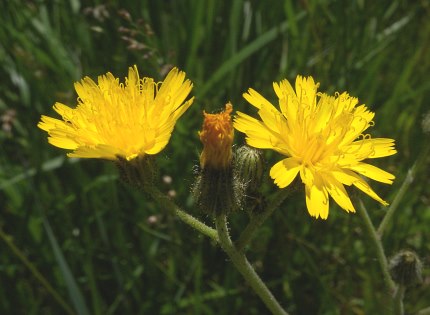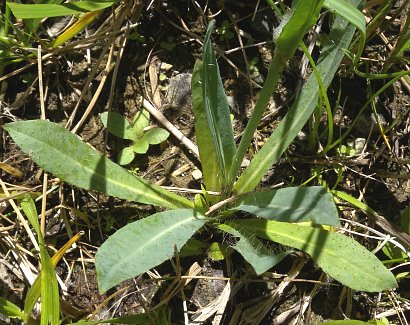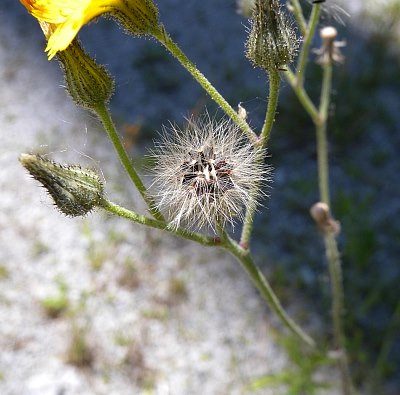
At the apex of the stalk, there is a flat-headed panicle of flowerheads that is usually more wide than it is tall (typically 3-6" across). The size of this panicle and the number of flowerheads is highly variable (typically 5-30 flowerheads, but sometimes more). The light green branches of the panicle are short-pubescent and they have scattered long hairs that are glandular and sticky. Each flowerhead spans about ¾" across, consisting of numerous yellow ray florets and no disk florets. The petaloid rays have truncate tips with 5 teeth. Around the base of each flowerhead, there are 10-20 floral bracts (phyllaries) that are arranged in a single series. These floral bracts are dull green, linear-lanceolate in shape, and short pubescent. Along the middle of each floral bract, there is a row of long black hairs that are glandular and sticky. The blooming period occurs from late spring to mid-summer and lasts about a month. In the absence of cross-pollination, the florets are capable of self-pollination. The florets are replaced by achenes that are about 1/8" (3-4 mm.) long at maturity. These achenes are dark reddish brown and narrowly bullet-shaped. At the truncate apex of each achene, there is attached a small tuft of white hairs. Achenes are distributed by the wind. The root system is fibrous; stolons are not produced.
Cultivation: Glaucous King Devil prefers full to partial sun, mesic to dry-mesic conditions, and barren soil containing sand, gravel, or rocky material.

Range & Habitat: Glaucous King Devil has been introduced to North America from Europe. In Illinois, where this weedy wildflower is rare, it has been found in only Lake County (see Distribution Map). However, it is possible that this species has spread to other counties of NE Illinois. Glaucous King Devil is more common in areas that lie to the north and east of the state (e.g., Wisconsin and Michigan). Habitats consist of sandy meadows, openings in sandy woodlands, areas along railroads and roadsides, and areas along sandy paths. While this species is still uncommon in Illinois, it is potentially invasive.
Faunal Associations: The nectar and pollen of the flowerheads attract bumblebees, other bees, butterflies, skippers, and Syrphid flies (Eastman, 1999). Hawkweeds are suspected host plants of Schinia bina (Bina Flower Moth), whose larvae are known to feed destructively on the flowerheads of other species in the Aster family (Asteraceae). Vertebrate animals make limited use of hawkweeds. The Ruffed Grouse and Wild Turkey feed on the young leaves and seeds; the seeds are also eaten by the American Goldfinch. The Cottontail Rabbit, White-Tailed Deer, and Elk browse on the bitter foliage occasionally, but it is not preferred as a source of food. Cattle reportedly avoid consumption of the foliage (Georgia, 1907).

Photographic Location: Along a sandy path at the Indiana Dunes National Lakeshore in NW Indiana.
Comments: Because this and similar hawkweeds (Hieracium spp.) from Europe were troublesome invaders of fields, early farmers in North America referred to them as 'King Devil' and similar names. There are also native hawkweeds, but they are usually found in savannas rather than fields and other disturbed areas. While native species of this genus in Illinois have leafy stems, those from Europe have leafless stems, or only 1-2 leaves toward the base of a stem. Glaucous King Devil is somewhat similar in appearance to another European species, Yellow King Devil (Hieracium caespitosum), but this latter species has a more compact inflorescence and its stems are more hairy. Another European species, Orange Hawkweed (Hieracium auriantiacum), can be easily distinguished from the proceeding species by its bright orange flowerheads. A scientific synonym of Glaucous King Devil is Hieracium florentinum.